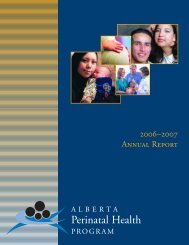Assistive Reproductive Technologies: A Literature Review and ...
Assistive Reproductive Technologies: A Literature Review and ...
Assistive Reproductive Technologies: A Literature Review and ...
Create successful ePaper yourself
Turn your PDF publications into a flip-book with our unique Google optimized e-Paper software.
n DiscussionComparisons between plurality <strong>and</strong> birth weightGreater health services costs were observed in LBW infants (compared to NBWinfants), twins (compared to singletons), <strong>and</strong> HOM (compared to singletons).This is not surprising because costs are expected to increase with greater birthplurality <strong>and</strong> lower birth weight. However, an interaction effect was observedbetween increasing plurality <strong>and</strong> lower birth weight indicating that LBW twins<strong>and</strong> LBW HOM are associated with significantly higher hospital <strong>and</strong> physiciancosts than singletons. In fact, the mean total cost of LBW twins <strong>and</strong> LBW HOMwere respectively, 5.88 ($14,253 vs. $2425) <strong>and</strong> eight times ($19,435 vs. $2425)greater than that of NBW singletons.The significantly greater health services costs associated with twins <strong>and</strong> HOMis particularly relevant in relation to ARTs because twins <strong>and</strong> HOM were foundto be highly predictive of being born LBW in the data <strong>and</strong> ARTs are associatedwith generating disproportionately greater birth pluralities. Twins had a 49%probability of being LBW <strong>and</strong> HOM had a 95% probability of being LBW(singletons had a 4.6% chance of being born LBW).Furthermore, the greater health care costs associated with twins <strong>and</strong> HOM(compared to singletons) were not likely driven by the volume of total visits.Although there were statistically significant differences in the number of hospitalvisits observed between singletons, twins, <strong>and</strong> HOM, the differences were smallin magnitude (less than one visit) <strong>and</strong> no statistically significant differences wereobserved for physician visits. This suggests that the greater costs associated withtwins <strong>and</strong> HOM (compared to singletons) are attributed to experiencing moresevere health conditions.Results for mothers were similar to infants. While health services costs weregreater for mothers of twins <strong>and</strong> HOM (compared to singletons) <strong>and</strong> for mothersof LBW infants (compared to NBW infants), the combination of greater plurality<strong>and</strong> lower birth weight significantly increased health services costs. Furthermore,greater costs observed in mothers of twins <strong>and</strong> HOM (compared to mothers ofsingletons) are likely attributed to experiencing more severe health conditions.Costs potentially attributable to ARTsThe available data did not identify which pregnancies resulted from ARTsprocedures. Consequently, estimating the health services costs attributable toARTs requires an assumption regarding the proportion of twins <strong>and</strong> HOM birthsattributable to ARTs procedures. Furthermore, estimating the potential costsavings had these twins <strong>and</strong> HOM been singleton pregnancies needs to accountfor the proportion of singletons that would still have been born LBW.26 <strong>Assistive</strong> <strong>Reproductive</strong> <strong>Technologies</strong>:a <strong>Literature</strong> <strong>Review</strong> <strong>and</strong> Database Analysis
















